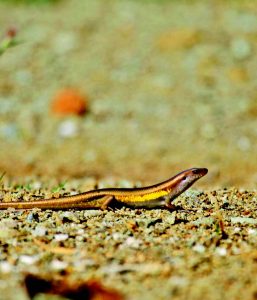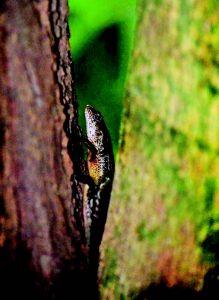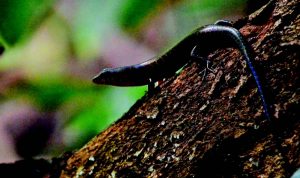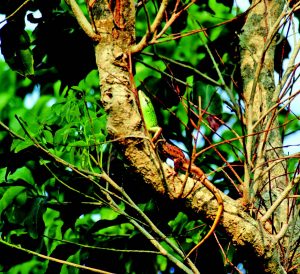After a decade of exploring wild mountain peaks, navigating through leech-infested swamps and trekking through moist misty forests to find and photograph Philippine wildlife, I’ve finally compiled enough images of skinks—those little lizards which scuttle up and down trees, in parks and schools nationwide.
Around 1,500 skink species have been discovered globally and at least 56 live in the Philippines, where we call them “bubuli.” They eat mostly insects and are harmless—so don’t run off the next time you see one! Through these photos, allow me to introduce you to the various skinks I’ve met in jungles and forests of our country.
Eutropis multifasciata

Golden flanks glittering in the morning light, this common brown skink (Eutropis multifasciata) was sunning itself in the sand dunes of Ilocos Norte. Usually just a plain olive or brown, the species exhibits great variance in colors, with colors becoming more vivid during the breeding season.
Slender Tree Skink This juvenile yellow-striped Slender Tree skink (Lipinia pulchella) was climbing a tree just meters away from me in Mount Makiling! Jaw-droppingly gorgeous, it’s endemic to the Philippines and scuttles up tree trunks from 250 to 1,100 meters in height in many misty mountain forests. Though tiny, they’re hard to miss because of their bold colors. I quietly left this guy to have breakfast after a few shots.
This juvenile yellow-striped Slender Tree skink (Lipinia pulchella) was climbing a tree just meters away from me in Mount Makiling! Jaw-droppingly gorgeous, it’s endemic to the Philippines and scuttles up tree trunks from 250 to 1,100 meters in height in many misty mountain forests. Though tiny, they’re hard to miss because of their bold colors. I quietly left this guy to have breakfast after a few shots.
Eutropismultifasciata
 This common brown skink (Eutropismultifasciata) was chilling on a log and seemed pretty happy to pose for the camera.
This common brown skink (Eutropismultifasciata) was chilling on a log and seemed pretty happy to pose for the camera.
The Eight-inch Skink

I ran into this giant, eight-inch skink in a malaria-infested swamp. It was hot, humid, and dangerous—but that’s where the wild things are.
The Chillest Skink

This was the chillest skink of them all. It just didn’t move the whole time I was skulking around it! Looks kind of like a Diplodocus, doesn’t it?
Philippine Spotted Tree Skink

This is one of the more colorful ones—a Philippine Spotted Tree skink (Lamprolepis smaragdina philippinica) hanging out in a tree somewhere in Northern Luzon.
Slender Tree Skink

Another Slender Tree skink which scuttled right past me. These juveniles are small–no more than three inches.
The Professor Weighs In
Last October, we featured another beautifully photographed picture story on stick insects by Wally Suarez of Philippine Biodiversity Net. (Editor’s note: His story on phasmids came out in our September 2017 issue!) This time, he comments on the subjects of Gregg’s photos: “Most people are familiar with the sun skinks from the genus Eutropis, which are locally known as bubuli, timbabalak, or bangkalang. They are often found sunning themselves in the open during mornings – scurrying back to their hiding places when disturbed.”
“However, we have a wide assemblage of skinks occupying various ecological niches. Those from the genus Brachymeles burrow, while those from the genus Tropidophorus prefer freshwater banks and have armor-like scales which make them look like miniature crocodiles. Mangrove skinks from the genus Emoia inhabit intertidal zones but also climb trees. Members of the genus Dasia and Lipinia live in trees.”
This appeared in Animal Scene magazine’s November 2017 issue.






